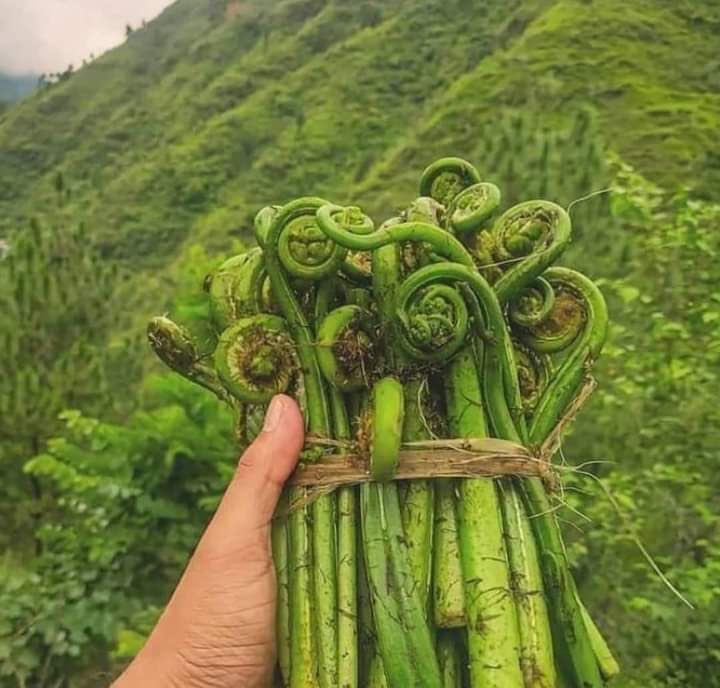Fiddlehead scientific name (Diplazium esculentum), is known by name Lungru लुंगड़ू or Lingaru in Himachal Pradesh and Nepal region. Lungru is a delectable edible fern found in the Himalayan state of Himachal Pradesh. Exclusive to the region, locals cherish this seasonal vegetable and use it to prepare scrumptious dishes and tangy pickles, reflecting their deep connection with the surrounding biodiversity. With its unique flavor and versatile uses, Lungru holds culinary significance and represents the sustainable coexistence of the people and their natural environment.
In the breathtaking landscapes of the Himalayan foothills, nestled within the serene beauty of Utrala, Baijnath, Himachal Pradesh, we, a group of nature enthusiasts, embarked on a memorable trek to a hot water spring in May 2021. Little did we know that this journey would spark a fascinating experiment that would combine our love for nature, biodiversity, and sustainable agriculture. During our trek, we discovered some plants of fiddleheads, the delightful coiled fronds of certain fern species. Inspired to cultivate these delicacies in our biodiverse farmland at Panchrukhi, we initiated a unique experiment, eagerly venturing into the world of fiddlehead cultivation.
The Seed of Inspiration
The journey to the hot water spring in Utrala not only rejuvenated our spirits but also introduced us to the fascinating world of fiddleheads. Drawn to their unique appearance and culinary appeal, we collected a couple of fiddlehead plants, brimming with curiosity and determination to explore the possibilities of cultivating them in our biodiverse farmland.
Nurturing the Experiment
Back at our home in Panchrukhi, we carefully planted the acquired fiddlehead plants in a strategic location on our land. Opting for a sheltered spot beneath other trees, which also had a gentle slope, we aimed to provide the ideal microclimate for the ferns to flourish. The richness of biodiversity in our farmland played a pivotal role in supporting the initial growth of the fiddleheads.
The Seed of Inspiration
The journey to the hot water spring in Utrala not only rejuvenated our spirits but also introduced us to the fascinating world of fiddleheads. Drawn to their unique appearance and culinary appeal, we collected a couple of fiddlehead plants, brimming with curiosity and determination to explore the possibilities of cultivating them in our biodiverse farmland.
With dedicated care and attention, the plants thrived and, to our delight, produced fiddleheads in the following year. Encouraged by this success, we expanded our experiment further. In 2023, more fiddlehead plants were added to the mix, and what we discovered next was truly intriguing—natural reproduction. The ferns had propagated and multiplied on their own, a testament to the compatibility of the species with the local environment.
Cultivating Curiosity
Driven by a passion for sustainable farming practices and a desire to inspire others, we realized the potential of our experiment to encourage fellow farmers and nature enthusiasts to explore innovative approaches to land cultivation. By sharing our experiences and the positive outcomes of fiddlehead cultivation, we aimed to challenge traditional farming mindsets and foster a spirit of experimentation among like-minded individuals.
With our rich biodiverse farmland as a living example, we sought to emphasize the importance of preserving local ecosystems and supporting native plant species. The Himalayan foothills, with its diverse climates and unique habitats, provided the ideal canvas for this agricultural exploration.
A Call to Action
As the fiddlehead experiment continues to yield fruitful results, we passionately encourage others to think outside the box and consider similar ventures on their own land. Sustainable agricultural practices and experimentation with native species can not only contribute to personal sustenance but also play a vital role in conserving the region’s rich biodiversity.
By breaking free from conventional farming norms and embracing the potential of diverse ecosystems, farmers can discover new and exciting opportunities for growth and nourishment. Additionally, fostering a spirit of collaboration and knowledge sharing within the community can lead to collective progress and a more resilient agricultural landscape.
Abstract:
In the charming environs of Panchrukhi, Himachal Pradesh, a simple trek to a hot water spring sparked a profound journey of discovery and inspiration. The fiddlehead experiment stands as a testament to the power of curiosity, innovation, and sustainable agriculture in the biodiversity-rich Himalayan foothills. With each fiddlehead sprout that unfurls, a seed of change is sown, encouraging us and others to embrace novel ideas and create a greener, more sustainable future for generations to come.
